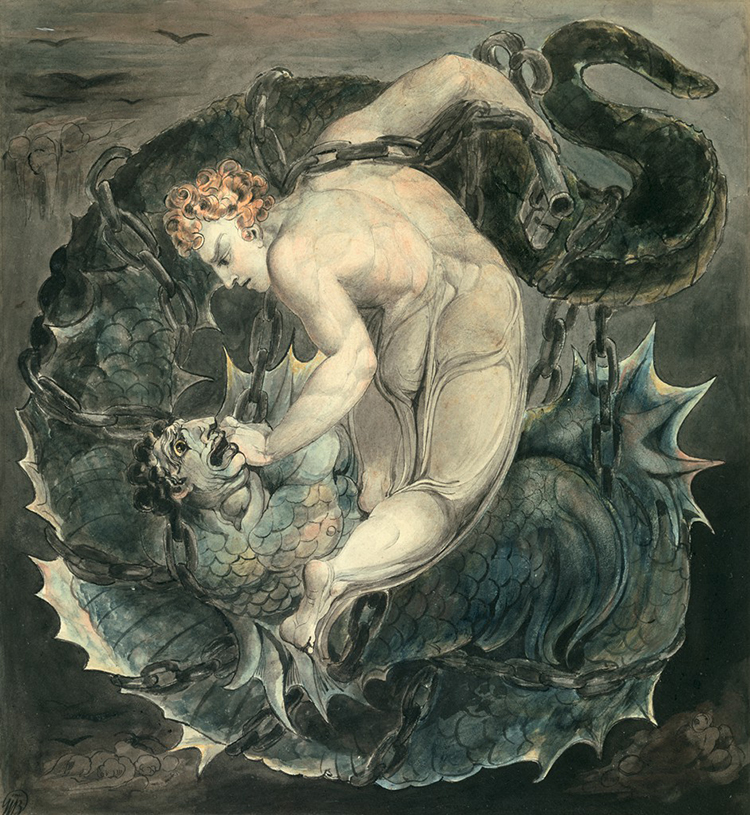This memorial note is by Kenneth Gross, who teaches English at the University of Rochester. His books include Spenserian Poetics: Idolatry, Iconoclasm, and Magic; The Dream of the Moving Statue; Shakespeare’s Noise; Shylock Is Shakespeare; and Puppet: An Essay on Uncanny Life. It will also appear in the winter issue of the Blake Quarterly.
The poetry of William Blake was wrought deeply into the bones of Harold Bloom’s thinking about literature. Northrop Frye’s Fearful Symmetry, which he discovered as a young classics major at Cornell, gave him both Blake as a poet and something in his own vocation as critic. Frye’s book “ravished my heart away,” he said in an interview with Imre Salusinzky published in 1986. “I thought it was the best book I’d ever read about anything. I must have read it a hundred times between 1947 and 1950, probably intuitively memorized it, and will never escape the effect of it.” Bloom’s third book was Blake’s Apocalypse: A Study in Poetic Argument (1963), an ambitious attempt to map the conceptual and imaginative shape of Blake’s whole body of work, from the early lyrics to the late prophecies—a project carried into his brilliant and idiosyncratic commentaries to David Erdman’s groundbreaking edition of Blake’s poetry and prose (1965). Bloom was always alive to Blake’s way of joining visionary, esoteric wildness and blunt, skeptical, satirical rage. He treasured Blake’s cheerful independence, his dark sense of humor, his willingness to think through for himself all ideas and traditions, his hatred of the mind’s capacity to accept and forge limitations for itself and others, and his ambition of “opening up the reader’s own buried capacity for imaginative self-liberation.”
Blake was also crucial to Bloom’s radical account of poetic influence. On a basic level, he looked to the example of Blake’s naked struggles to make his own the legacies of the Bible and of Milton, combining violent critique with imaginative transformation. The prose of The Marriage of Heaven and Hell also provided one model for Bloom’s experiments with gnomic fable and aphorism in The Anxiety of Influence (1973). More particularly, Bloom’s central image of the precursor poet not as benign source but as darkly powerful “Covering Cherub” derives from Blake’s reading of Ezekiel’s vision of “the … cherub that covereth” in Ezekiel 28.14. The Covering Cherub appears in Milton as “Miltons Shadow … / The Spectre of Albion,” a shape in which are seen “the Dragon Forms / Religion hid in War, a Dragon red & hidden Harlot” (plate 37). The Cherub appears later in Jerusalem as a “reveald majestic image / Of Selfhood … / … a Human Dragon terrible / And bright” (plate 89). It’s worth noting that Bloom first deployed this figure in his 1970 study of Yeats, where he mapped the Irish poet’s emergent struggle with the necessary if also deforming influences of Blake and Shelley.
For myself, when I try to imagine the uncanny, agonistic work of poetic revision as Bloom described it, to give it physical form, what comes to mind is always Blake’s description of the silent striving between Urizen and Milton on the shores of the River Arnon in Milton (plate 19). Here the jealous father-god, with his cold hand, pours an icy baptismal water into Milton’s brain, while the poet circles Urizen, taking up “red clay” from the shore, “moulding it with care / Between his palms: and filling up the furrows of many years,” pressing it into and around Urizen’s dead skeletal form, trying to bring that demon-god, and himself, back to life, “building him, / As with new clay a Human form.” It’s a scene that offers Blake’s own wild revision and intertwining of two moments in Genesis, Yahweh’s forming the body of Adam from red clay and Jacob’s nightlong struggle with a nameless spirit, “some man,” at the ford of the Jabbok—a spirit that Bloom thought not a messenger of God but “the angel of death.” Jacob’s is a wrestling match that leaves the exiled trickster and patriarch limping, but with a new name and a new future, a blessing of “more life.” Bloom as a critic said, with Blake, “I must Create a System, or be enslav’d by another Mans” (Jerusalem, plate 10).
Bloom wrote much less about Blake in his later work. Blake has no substantive section of his own in The Western Canon: The Books and School of the Ages (1994), nor in Where Shall Wisdom Be Found? (2004)—though he wonderfully shares a chapter of Genius: A Mosaic of One Hundred Exemplary Creative Minds (2002) with D. H. Lawrence, Tennessee Williams, Rainer Maria Rilke, and Eugenio Montale. And Bloom never failed to honor Blake’s urgency and originality. As he wrote in 2010, in a note in his anthology Till I End My Song: A Gathering of Last Poems, “in my judgment, only William Shakespeare and Emily Dickinson, among the poets, were as conceptually independent and powerful as Blake, who held to the Inner Light tradition of radical Protestantism.”
A last, curious note: I and others among his former students and friends often observed that in Blake’s watercolor Michael Binding Satan the human face that appears on the serpentine body of Satan, a face that is powerful and full of dismay, looks very like the face of Harold Bloom. Perhaps that’s because, as is apparent from contemporary portraits and caricatures, Bloom bore an uncanny resemblance to the radical Whig Charles James Fox. Humorist that Bloom was, he himself might have relished appearing in a Blake painting under the guise of the Enemy.

Harvard Art Museums/Fogg Museum, Gift of W. A. White. 1915.8.
